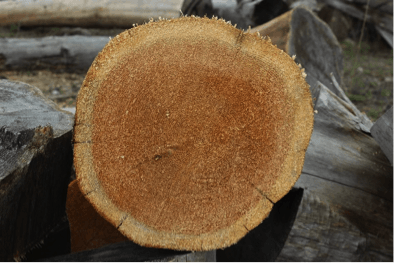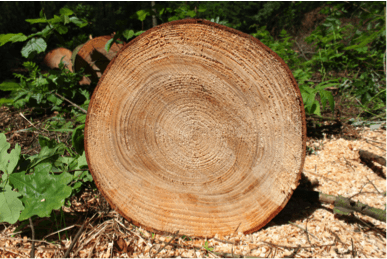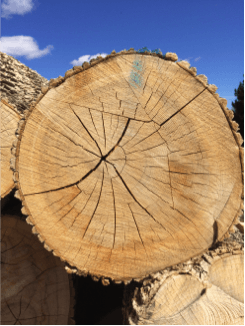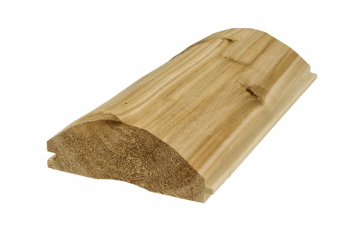When considering a wood or log home building project it is critical to understand the different qualities and limitations of the wood species you wish to use. ALL WOOD SPECIES ARE NOT EQUAL! In the following article we outline the key difference between fast growing and slow growing woods, and why that makes Northern White Cedar a first choice wood for building material.
All trees have layers of growth commonly referred to as “rings”. A crosscut of a mature tree trunk, with outer bark removed, reveals two different sections of rings easily distinguished by color.

Northern White Cedar
The outer rings are sapwood and are commonly lighter colored. This is the part of the tree through which sap flows to sustain tree growth. It contains water and sap which, in order for the lumber to be used for building, must be carefully dried prior to use. Sapwood will shrink and crack more easily over time and it is more susceptible to fungus and decay. While sapwood plays a vital role in the tree’s nourishment in when growing, it is not a recommended product for woodworking.
The inner, darker rings of the trunk are called the heartwood – being closer to the heart or center of the tree. They are formed from, so to speak, “retired” sapwood which dries out over time as the sap stops flowing through these layers of the tree. As this happens the drying tree pores fill up with organic matter and the cell walls change color. As this part of the wood has naturally less moisture it is more easily kiln dried to ensure optimum moisture content for use as building material.

White Pine
What is critical to note is that some tree species naturally have greater quantities of sapwood than heartwood. Having more sapwood in a tree trunk can mean that the wood producers must take additional steps to assure that the lumber produced is acceptable for building. Pine, for example, has a larger band of sapwood than does Northern White Cedar. Likewise, each tree species differs in the rate at which sapwood is converted to heartwood. In some tree species, color differences between sapwood and heartwood are hard to determine, requiring an expert’s verification prior to harvesting for lumber. Species which fall into this latter category include hemlock, cottonwood, aspen, the true firs and most spruces.

Ash
Some species, commonly slow growing trees, begin to form heartwood very early in life – thus having only a thin layer of live sapwood. Yet other trees create wide bands of sapwood, and small central bands of heartwood. These are often faster growing trees. Thin sapwood is characteristic of such species as chestnut, black locust, mulberry, osage-orange, sassafras, and Northern White Cedar. While maple, ash, hickory, hackberry, beech, and pine – which are frequently harvested for structural lumber and log siding on some brands of log homes – thick sapwood is the rule, requiring longer drying time before use.

3″x8″ Hand Hewn Northern White Cedar Siding
At Heartwood Mills we recommend Northern White Cedar for log siding, timber siding, paneling, decking, stairs, railings and other wooden home building products. Some may argue that the initial cost is more since there is less available heartwood to harvest from the tree. While this is true in the initial construction costs, over the life of the home the homeowner will have the advantage because Northern White Cedar home finish products are proven to last years longer than pine or other sapwood products. With Northern White Cedar products, there is less shrinkage or cracking, less rot and decay, resulting in less maintenance and a longer product life. You save in the long term!
Heartwood Mills recommends that prior to purchasing make sure to qualify your building products purchases by asking these key questions:
1) Is the product I am buying formed of heartwood or sapwood, and of what species?
2) What method of drying was used?
3) What is the moisture content of the finished wood product?
4) Is there a usable product guarantee on the products purchased?
| Return to Main Page |
